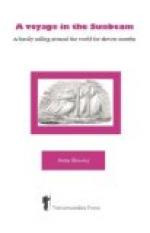The next thing to see was the weaving of silk, which is done in the most primitive manner. One man throws the shuttle, while another forms the pattern by jumping on the top of the loom and raising a certain number of threads, in order to allow the shuttle to pass beneath them.
Then came a visit to the Temple of Longevity, a large Buddhist temple, with a monastic establishment of about ninety priests attached to it. It contains three shrines with large figures, but nothing specially interesting. There is a large pond in the midst of the garden, covered with duckweed, and full of beautiful gold and silver fish of many kinds. The Chinese certainly excel in producing gold and silver and red fish; they are the pets of every household, and are of all colours, some being striped and spotted, and boasting any number of tails from one to five.
Outside the temple stands the Jadestone Market, where incredible quantities of this valuable stone change hands before ten o’clock every morning, both in its rough and its polished state. The stalls are the simplest wooden stands, and the appearance of the vendors is poor in the extreme. The contents of the stalls, however, are worth from 500_l_. to l,000_l_. (not dollars), and there are hundreds of these stalls, besides an entire jadestone street which we afterwards visited. We saw several of the shops, and asked the prices, as we wished to take home a small specimen; but they had no good carved cups, which were what we wanted, and for what they had they asked an enormous price. Jadestone is a material very difficult to work, and in many cases the result attained is not worth the labour expended upon it. It is more a tour de force than a work of art. For a good stone, green as grass (as it ought to be), they ask from 2,500 to 3,000 dollars; for a necklace of beads, 5,000 dollars; a set of mandarin’s buttons, one large and one small, 50 to 150 dollars.
After looking in at the goldbeaters at work, we next made our way to the temple of the Five Genii who are supposed to have founded the city of Canton. Being a Tartar temple, all the gods have a totally different cast of features, and are represented as Tartars with long beards. It is much frequented by women of all classes, and up and down the numerous flights of steps leading from one shrine to another, poor little women tottered and tumbled on their crippled feet, holding on to one another, or leaning on a stick. This temple is interesting as having been the head-quarters of the allied forces during their occupation of Canton from 1858 to 1861. The great bell in front of its principal shrine has been broken by a shot.
We then went to see the Flowery Pagoda, built A.D. 512, but now deprived of many of its decorations. The Brilliant Pagoda too, so called from having once been covered with snow-white porcelain, is now only a tall brick-pointed tower nine stories high.




